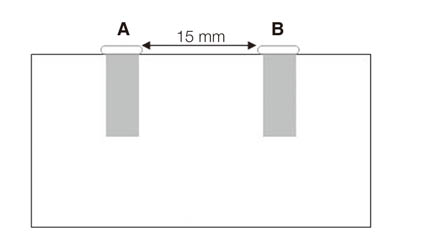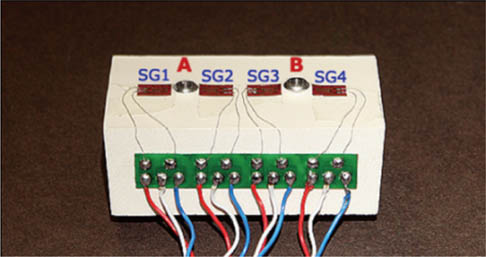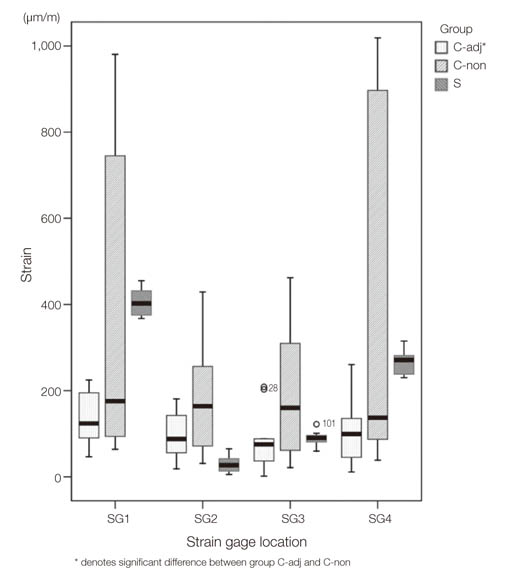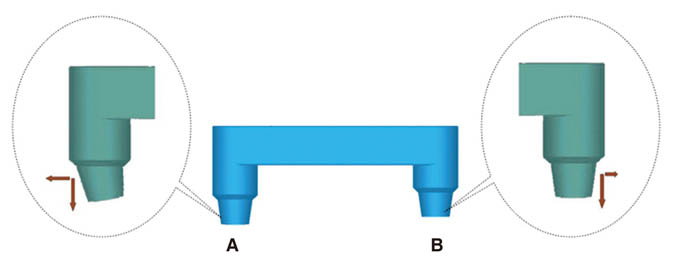J Adv Prosthodont.
2013 Aug;5(3):312-318. 10.4047/jap.2013.5.3.312.
Comparative study on stress distribution around internal tapered connection implants according to fit of cement- and screw-retained prostheses
- Affiliations
-
- 1Department of Prosthodontics, School of Medicine, Ewha Womans University, Seoul, Republic of Korea. jimarn@ewha.ac.kr
- 2Department of Prosthodontics, School of Dentistry, Seoul National University, Seoul, Republic of Korea.
- KMID: 2118171
- DOI: http://doi.org/10.4047/jap.2013.5.3.312
Abstract
- PURPOSE
The aim of this study was to compare the passivity of implant superstructures by assessing the strain development around the internal tapered connection implants with strain gauges.
MATERIALS AND METHODS
A polyurethane resin block in which two implants were embedded served as a measurement model. Two groups of implant restorations utilized cement-retained design and internal surface of the first group was adjusted until premature contact between the restoration and the abutment completely disappeared. In the second group, only nodules detectable to the naked eye were removed. The third group employed screw-retained design and specimens were generated by computer-aided design/computer-aided manufacturing system (n=10). Four strain gauges were fixed on the measurement model mesially and distally to the implants. The strains developed in each strain gauge were recorded during fixation of specimens. To compare the difference among groups, repeated measures 2-factor analysis was performed at a level of significance of alpha=.05.
RESULTS
The absolute strain values were measured to analyze the magnitude of strain. The mean absolute strain value ranged from 29.53 to 412.94 microm/m at the different strain gauge locations. According to the result of overall comparison, the cement-retained prosthesis groups exhibited significant difference. No significant difference was detected between milled screw-retained prostheses group and cement-retained prosthesis groups.
CONCLUSION
Within the limitations of the study, it was concluded that the cement-retained designs do not always exhibit lower levels of stress than screw-retained designs. The internal adjustment of a cement-retained implant restoration is essential to achieve passive fit.
Keyword
Figure
Reference
-
1. Rudd KD, O'Leary TJ, Stumf AJ. Horizontal tooth mobility in carefully screened subjects. Periodontology. 1964; 4:65–70.2. Sekine H, Komiyama Y, Potta H, Yoshida K. Mobility characteristics and tactile sensitivity of osseointegrated fixture-supporting systems. In : van Steenberghe D, Albrektsson T, Branemark PI, Henry PJ, Holt R, Liden G, editors. Tissue integration in oral and maxillofacial reconstruction. Amsterdam: Excerpta Medica;1986. p. 326–329.3. Adell R, Lekholm U, Rockler B, Brånemark PI. A 15-year study of osseointegrated implants in the treatment of the edentulous jaw. Int J Oral Surg. 1981; 10:387–416.4. Lundqvist S, Carlsson GE. Maxillary fixed prostheses on osseointegrated dental implants. J Prosthet Dent. 1983; 50:262–270.5. Lekholm U, Adell R, Brånemark P-I. Complications. In : Brånemark P-I, Zarb GA, Albrektsson T, editors. Tissue-Integrated Prostheses: Osseointegration in Clinical Dentistry. Chicago: Quintessence;1985. p. 233–240.6. Rangert B, Jemt T, Jörneus L. Forces and moments on Branemark implants. Int J Oral Maxillofac Implants. 1989; 4:241–247.7. Spector MR, Donovan TE, Nicholls JI. An evaluation of impression techniques for osseointegrated implants. J Prosthet Dent. 1990; 63:444–447.8. Michalakis KX, Hirayama H, Garefis PD. Cement-retained versus screw-retained implant restorations: a critical review. Int J Oral Maxillofac Implants. 2003; 18:719–728.9. Taylor TD. Prosthodontic problems and limitations associated with osseointegration. J Prosthet Dent. 1998; 79:74–78.10. Goodacre CJ, Kan JY, Rungcharassaeng K. Clinical complications of osseointegrated implants. J Prosthet Dent. 1999; 81:537–552.11. Kallus T, Bessing C. Loose gold screws frequently occur in full-arch fixed prostheses supported by osseointegrated implants after 5 years. Int J Oral Maxillofac Implants. 1994; 9:169–178.12. Jemt T. Failures and complications in 391 consecutively inserted fixed prostheses supported by Brånemark implants in edentulous jaws: a study of treatment from the time of prosthesis placement to the first annual checkup. Int J Oral Maxillofac Implants. 1991; 6:270–276.13. Naert I, Quirynen M, van Steenberghe D, Darius P. A study of 589 consecutive implants supporting complete fixed prostheses. Part II: Prosthetic aspects. J Prosthet Dent. 1992; 68:949–956.14. Adell R, Eriksson B, Lekholm U, Brånemark PI, Jemt T. Long-term follow-up study of osseointegrated implants in the treatment of totally edentulous jaws. Int J Oral Maxillofac Implants. 1990; 5:347–359.15. Jemt T, Book K. Prosthesis misfit and marginal bone loss in edentulous implant patients. Int J Oral Maxillofac Implants. 1996; 11:620–625.16. Rangert B, Krogh PH, Langer B, van Roekel N. Bending overload and implant fracture: a retrospective clinical analysis. Int J Oral Maxillofac Implants. 1995; 10:326–334.17. Tan KB. The clinical significance of distortion in implant prosthodontics: is there such a thing as passive fit? Ann Acad Med Singapore. 1995; 24:138–157.18. Heckmann SM, Karl M, Wichmann MG, Winter W, Graef F, Taylor TD. Cement fixation and screw retention: parameters of passive fit. An in vitro study of three-unit implant-supported fixed partial dentures. Clin Oral Implants Res. 2004; 15:466–473.19. Karl M, Winter W, Taylor TD, Heckmann SM. In vitro study on passive fit in implant-supported 5-unit fixed partial dentures. Int J Oral Maxillofac Implants. 2004; 19:30–37.20. Taylor TD, Agar JR, Vogiatzi T. Implant prosthodontics: current perspective and future directions. Int J Oral Maxillofac Implants. 2000; 15:66–75.21. Chiche GJ, Pinault A. Considerations for fabrication of implant-supported posterior restorations. Int J Prosthodont. 1991; 4:37–44.22. Pietrabissa R, Gionso L, Quaglini V, Di Martino E, Simion M. An in vitro study on compensation of mismatch of screw versus cement-retained implant supported fixed prostheses. Clin Oral Implants Res. 2000; 11:448–457.23. Guichet DL, Caputo AA, Choi H, Sorensen JA. Passivity of fit and marginal opening in screw- or cement-retained implant fixed partial denture designs. Int J Oral Maxillofac Implants. 2000; 15:239–246.24. Guichet DL. Load transfer in screw- and cement-retained implant fixed partial denture designs [abstract]. J Prosthet Dent. 1994; 72:631.25. Misch CE. Screw-retained versus cement-retained implant-supported prostheses. Pract Periodontics Aesthet Dent. 1995; 7:15–18.26. Kim WD, Jacobson Z, Nathanson D. In vitro stress analyses of dental implants supporting screw-retained and cement-retained prostheses. Implant Dent. 1999; 8:141–151.27. Williams WN, La Pointe LL, Blanton RS. Human discrimination of different bite forces. J Oral Rehabil. 1984; 11:407–413.28. Kikuchi M, Korioth TW, Hannam AG. The association among occlusal contacts, clenching effort, and bite force distribution in man. J Dent Res. 1997; 76:1316–1325.29. Watanabe F, Uno I, Hata Y, Neuendorff G, Kirsch A. Analysis of stress distribution in a screw-retained implant prosthesis. Int J Oral Maxillofac Implants. 2000; 15:209–218.30. Iplikçioğlu H, Akça K, Cehreli MC, Sahin S. Comparison of non-linear finite element stress analysis with in vitro strain gauge measurements on a Morse taper implant. Int J Oral Maxillofac Implants. 2003; 18:258–265.31. Karl M, Rosch S, Graef F, Taylor TD, Heckmann SM. Static implant loading caused by as-cast metal and ceramic-veneered superstructures. J Prosthet Dent. 2005; 93:324–330.32. Karl M, Wichmann MG, Winter W, Graef F, Taylor TD, Heckmann SM. Influence of fixation mode and superstructure span upon strain development of implant fixed partial dentures. J Prosthodont. 2008; 17:3–8.33. Karl M, Wichmann MG, Heckmann SM, Krafft T. Strain development in 3-unit implant-supported CAD/CAM restorations. Int J Oral Maxillofac Implants. 2008; 23:648–652.34. Stafford GD, Glantz PO. Intraoral strain gauge measurements on complete dentures: a methodological study. J Dent. 1991; 19:80–84.35. Bernal G, Okamura M, Muñoz CA. The effects of abutment taper, length and cement type on resistance to dislodgement of cement-retained, implant-supported restorations. J Prosthodont. 2003; 12:111–115.36. Clelland NL, Papazoglou E, Carr AB, Gilat A. Comparison of strains transferred to a bone simulant among implant overdenture bars with various levels of misfit. J Prosthodont. 1995; 4:243–250.37. Clelland NL, Carr AB, Gilat A. Comparison of strains transferred to a bone simulant between as-cast and postsoldered implant frameworks for a five-implant-supported fixed prosthesis. J Prosthodont. 1996; 5:193–200.38. Clelland NL, van Putten MC. Comparison of strains produced in a bone simulant between conventional cast and resin-luted implant frameworks. Int J Oral Maxillofac Implants. 1997; 12:793–799.39. Pietrabissa R, Contro R, Quaglini V, Soncini M, Gionso L, Simion M. Experimental and computational approach for the evaluation of the biomechanical effects of dental bridge misfit. J Biomech. 2000; 33:1489–1495.40. Nishioka RS, Nishioka LN, Abreu CW, de Vasconcellos LG, Balducci I. Machined and plastic copings in three-element prostheses with different types of implant-abutment joints: a strain gauge comparative analysis. J Appl Oral Sci. 2010; 18:225–230.41. Schwarz MS. Mechanical complications of dental implants. Clin Oral Implants Res. 2000; 11:156–158.42. Jemt T, Book K. Prosthesis misfit and marginal bone loss in edentulous implant patients. Int J Oral Maxillofac Implants. 1996; 11:620–625.43. Carr AB, Gerard DA, Larsen PE. The response of bone in primates around unloaded dental implants supporting prostheses with different levels of fit. J Prosthet Dent. 1996; 76:500–509.44. Eser A, Akça K, Eckert S, Cehreli MC. Nonlinear finite element analysis versus ex vivo strain gauge measurements on immediately loaded implants. Int J Oral Maxillofac Implants. 2009; 24:439–446.
- Full Text Links
- Actions
-
Cited
- CITED
-
- Close
- Share
- Similar articles
-
- Retrievable SCP (screw-cement prosthesis) implant-supported fixed partial dentures in a fully edentulous patient: a case report
- 3-D Finite element stress analysis in screw-type, cement-type, and combined-type implant fixed partial denture designs
- A Comparison Of Load Transfer In Screw-And Cement-Retained Implant Fixed Partial Denture Designs
- Burnishing effect on marginal misfit of implant-supported screw-and-cement retained prostheses: A case report
- Implant-Supported Fixed Dental Prostheses with New Retention Type Using Zirconia Ball and Nickel-Titanium Spring






